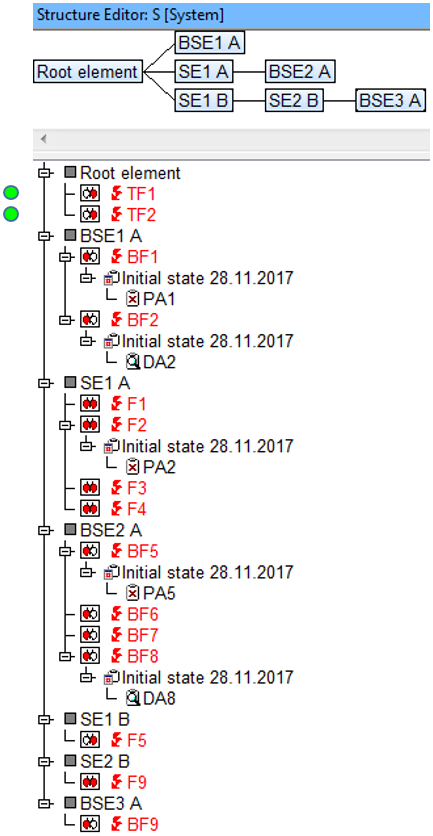Search:
Top failures with base failures that have incomplete actions
Explanation:
A search will be performed for top failures linked to base failures, whereby at least one base failure has no actions (preventive- or detection actions) assigned and at least one does.
Note:
- Top failures are failures that have causes but no effects.
- Base failures are failures that have effects but no causes.
Example:
Abbreviations
- ASIL = Automotive safety integrity level
- BF = Base failure of a base function
- BFn = Base function of a base structure element
- BSE = Base structure element
- Cl Prc = Classification for process characteristic
- Cl Prd = Classification for product characteristic
- Cl Req = Classification for requirement
- CM = Control method
- DA = Detection action
- DC = Diagnostic coverage
- DSCF = Dangerous safety critical failure
- Er Det = Error detection
- Er Resp = Error response
- F = Failure
- FIT = Failure in time
- Fn = Function
- FSM = Functional safety management
- IE = Inspection equipment
- LF = Latent fault
- LFM = Latent fault metric
- OC = Operating condition
- PA = Preventive action
- PE = Process element
- PFH = Probability of failure per Hour
- PMHF = Probabilistic metric for random hardware failures
- PrcC = Process characteristic
- PrdC = Product characteristic
- QM = Quality method
- QR = Quality rule
- Req = Requirement
- RMR = Risk Matrix Ranking
- RP = Reaction plan
- SE = Structure element
- SE ErDet = Structure element for error detections
- SE ErResp = Structure element for error responses
- SFF = Safe failure fraction
- SG = Safety Goal
- SIL = Safety integrity level
- SM = Organisational-SE for “safety mechanisms”
- SPF = Single point fault
- SPFM = Single point fault metric
- TF = Top failure of a top function
- TFn = Top function at root element
- TS = Test sample

- TF1 and TF2 are two top failures (TF) anchored in the root element of the structure shown above. If you choose to display actions in the structure list as a display option, you can immediately see which actions are anchored at which failures:
- In fact, another TF is also located in SE1 B, namely F5. The following images of the Graph Editor and Failure Net Editor show how the objects are linked.
- Via the display options, it is also possible to see where the actions are anchored in the failure net.
Graph Editor:

Failure Net Editor from viewpoint of TF:

Search result ![]() :
:
By viewing the failure net links, it is possible to see that there are two top failures linked to at least one base failure, which has neither a detection- nor preventive action assigned AND is linked to at least one base failure that does have at least one detection- or preventive action assigned. These are TF1 and TF2.